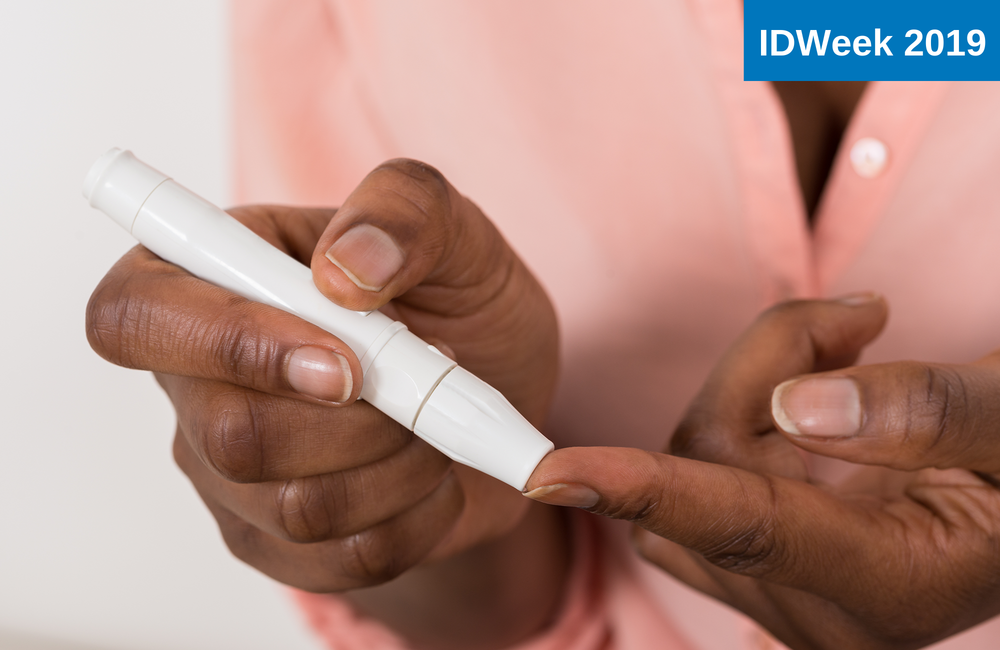
People who started antiretroviral therapy (ART) with a regimen that included an integrase inhibitor were more likely to develop diabetes mellitus, although this increased risk differed between specific drugs, researchers reported at the IDWeek 2019 conference in Washington, DC.
A growing body of evidence suggests that integrase inhibitors are linked to greater weight gain in people starting HIV treatment. However, the reasons for this are not yet well understood, nor is it clear whether increased weight gain is associated with other conditions such as diabetes and metabolic syndrome. Earlier in the epidemic, protease inhibitors were found to cause metabolic problems in people with HIV, but integrase inhibitors have been thought to cause fewer side effects.
Dr Peter Rebeiro of Vanderbilt University Medical Center in Tennessee and colleagues looked at the impact of initial ART classes and drugs on the development of diabetes among more than 21,000 participants in the North American AIDS Cohort Collaboration on Research and Design (NA-ACCORD).
The analysis included previously untreated adults starting ART regimens that included a non-nucleoside reverse transcriptase inhibitor (NNRTI), protease inhibitor or integrase inhibitor between 2007 and 2016.
Among the 21,516 eligible participants, 10,553 (49%) started NNRTIs, 6677 (31%) started protease inhibitors and 4286 (20%) started integrase inhibitors. Among those starting on integrase inhibitors, 51% used elvitegravir (Vitekta, also in the Stribild and Genvoya combination pills), 28% used raltegravir (Isentress) and 21% used dolutegravir (Tivicay, also in the Triumeq, Juluca and Dovato co-formulations).
Most participants (87%) were men and about 40% were white. However, the groups taking NNRTIs, protease inhibitors and integrase inhibitors differed in several respects, including median age (42, 41 and 38 years, respectively), median CD4 count (313, 262 and 360 cells/mm3) and amount of follow-up time (3.04, 2.35 and 1.64 years).
The participants were followed until they experienced virological treatment failure, changed the core component of their regimen or developed diabetes, defined as receiving diabetes medications (with or without a formal diagnosis of diabetes), having a haemoglobin A1c (HbA1c) percentage above 6.5% or having a random glucose measurement of 200 mg/dl or greater.
Overall, 3% of the participants developed diabetes. By drug class, the incidence rates for people taking NNRTIs, protease inhibitors and integrase inhibitors were 9.24, 11.82 and 12.03 per 1000 person-years, respectively.
Those starting integrase inhibitors were 22% more likely to develop diabetes than those taking NNRTIs, a difference that fell just short of statistical significance. This was similar to the 25% added risk for those taking protease inhibitors compared with NNRTIs, which was statistically significant.
Among those starting integrase inhibitors, the diabetes incidence rates were 10.73, 16.22 and 15.57 per 1000 person-years for those who took elvitegravir, raltegravir and dolutegravir, respectively. Starting raltegravir was associated with a significant 50% increased risk of diabetes compared with NNRTIs, but starting dolutegravir (14%) or elvitegravir (-4%) were not linked to significant elevations.
Initiating ART with integrase inhibitor or protease inhibitor versus NNRTI-based regimens "may confer increased risk of incident [diabetes]," though the risk is variable among specific integrase inhibitors, the researchers concluded. They added that, "Further research is needed to determine if this elevated risk can be attributed to weight gain."
In a related presentation, researchers from Thomas Jefferson University in Philadelphia described a retrospective study of 90 people with suppressed virus who switched from a NNRTI or a protease inhibitor to an integrase inhibitor between 2015 and 2017.
Here, just over 80% were men, a third were white and the median age was about 50. At the time of the switch, 30% were classified as normal weight, 42% as overweight and 26% as obese. Two-thirds switched to regimens containing elvitegravir and a third switched to dolutegravir.
After the switch, the median weight gain was 1.7kg overall. But the median increase was much greater, at 4.4kg, for the seven people who switched to a regimen containing both dolutegravir and tenofovir alafenamide (TAF) – a bigger gain than was seen in those who switched to either elvitegravir plus TAF or dolutegravir without TAF. However, this weight gain was not associated with notable changes in either haemoglobin A1c or blood lipid levels.
Rebeiro P et al. The effect of initiating integrase inhibitor-based vs. non-nucleoside reverse transcriptase inhibitor-based antiretroviral therapy on progression to diabetes among North American persons in HIV care. IDWeek, Washington, DC, abstract LB9, 2019.
Update: Following the conference presentation, this study was published in a peer-reviewed journal:
Rebeiro P et al. Risk of Incident Diabetes Mellitus, Weight Gain, and their Relationships with Integrase Inhibitor-based Initial Antiretroviral Therapy Among Persons with HIV in the US and Canada. Clinical Infectious Diseases, ciaa1403, online ahead of print, September 2020.
doi: 10.1093/cid/ciaa1403
Zimmerman M et al. Exploring the prevalence and characteristics of weight gain and other metabolic changes in patients with HIV infection switching to integrase inhibitor containing ART. IDWeek, Washington, DC, abstract 981, 2019.

